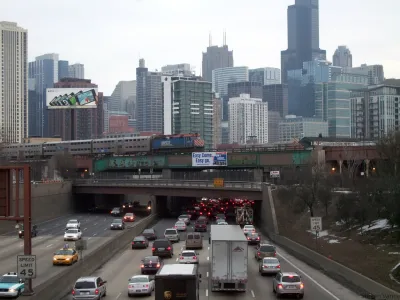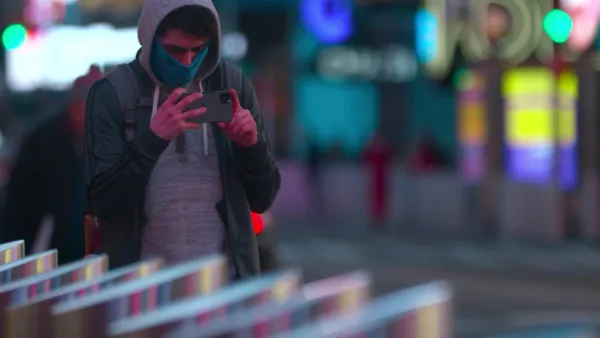The most transit-oriented metro areas often have lower levels of traffic congestion than one might expect based on their size.

A few weeks ago, Wendell Cox wrote a blog post asserting that the most dense metros tend to have the highest levels of congestion. Assuming for the sake of argument that his methodology for measuring congestion makes sense, it does not necessarily follow that sprawl equals low congestion, or that transit-oriented development equals high congestion.
Cox focuses on metrowide density. But there are different kinds of density; some regions, such as Los Angeles, have high regionwide density but so-so transit systems, car-oriented street design, and a not-too-dense central city. Others, such as Boston, combine a very dense, transit-oriented core with not-so-dense suburbs. Regions in the first group tend to have low transit ridership, thus effectively combining density and sprawl. In addition, large regions are likely to have higher congestion than small regions, even leaving aside density.
So I thought I would take a look at Cox's data and ask a slightly different question: do transit-oriented places have more congestion than one might expect for their size, or less?
Exhibit A is New York City: the region with the highest transit ridership in the United States. Since New York is the largest region in the nation, one might expect it to have high levels of congestion. But according to Cox, New York is only fourth in congestion. Thus, it appears that a highly dense core, when combined with less-dense suburbs, will have levels of congestion lower than one might expect based on population.
Five other large regions (Philadelphia, Chicago, Boston, San Francisco, and Washington) have highly transit-oriented central cities: that is, cities where over 25 percent of residents use transit to get to work. All of these cities have fairly high central-core density; all but one (Washington) that is, over 10,000 people per square mile within the city limits, and Washington is pretty close to the 10,000/square mile mark.* In fact, five of these cities (all but Washington) are the five most dense principal cities (that is, largest city in their metropolitan area) in the United States.
Philadelphia has the fifth highest regional population, but only the thirteenth highest level of congestion. Thus, Philadelphia clearly outperforms its population in addressing traffic congestion—that is, it has less congestion than one might expect from its size.
Chicago has the third highest regional population, but only the 12th highest level of congestion. Thus, Chicago again outperforms expectations.
On the other hand, two other transit-oriented regions do not outperform. Boston has the tenth highest population but the eighth highest level of congestion, and San Francisco has the eleventh highest population but the third highest level of congestion. (Washington ranks no. 7 in both).
On balance, transit-oriented regions do not seem to have more traffic congestion, controlling for size, than the nation as a whole.
*Washington has 61 square miles and 602,000 people, according to the 2010 Census.

Analysis: Cybertruck Fatality Rate Far Exceeds That of Ford Pinto
The Tesla Cybertruck was recalled seven times last year.

National Parks Layoffs Will Cause Communities to Lose Billions
Thousands of essential park workers were laid off this week, just before the busy spring break season.

Retro-silient?: America’s First “Eco-burb,” The Woodlands Turns 50
A master-planned community north of Houston offers lessons on green infrastructure and resilient design, but falls short of its founder’s lofty affordability and walkability goals.

Test News Post 1
This is a summary

Analysis: Cybertruck Fatality Rate Far Exceeds That of Ford Pinto
The Tesla Cybertruck was recalled seven times last year.

Test News Headline 46
Test for the image on the front page.
Urban Design for Planners 1: Software Tools
This six-course series explores essential urban design concepts using open source software and equips planners with the tools they need to participate fully in the urban design process.
Planning for Universal Design
Learn the tools for implementing Universal Design in planning regulations.
EMC Planning Group, Inc.
Planetizen
Planetizen
Mpact (formerly Rail~Volution)
Great Falls Development Authority, Inc.
HUDs Office of Policy Development and Research
NYU Wagner Graduate School of Public Service





























